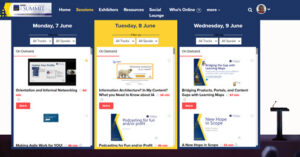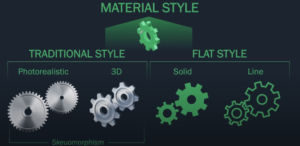by Mellissa Ruryk
Trying to think of an exciting topic for my contribution to the IDL newsletter, I remembered that our Programs volunteer, Viqui Dill, was published in the May/June 2021 issue of intercom, theme of which was Inclusivity in Technical Communication. Her article was about how to become an ally of neurodiverse persons. It also reminded me of our upcoming First Fridays at 5 session on October 1, called The meaning of words—learnings from health care, presented by Kristie Nicol.
I thought of the many articles I’ve read this year on diversity, the topics of gender identity, “political correctness,” “cancel culture,” and language inclusivity. I am also a member of the #deiap-stc channel in the STC Slack Workspace.
I researched and gathered some choice words and phrases that perpetuate harmful and inaccurate stereotypes; I added a few of my own. The sidebar discusses why stereotypes contribute to bias.
Please comment on this topic—which words did I miss? I want to engage with anyone who wants to discuss these concepts more.
| Exclusive or stereotyping term | Inclusive choices | Notes |
| Black hat | unethical | Using black to indicate something bad, wrong or undesirable. |
| Blacklist | deny (or denied) list | See above. |
| Dear Sirs | Ladies and gentlemen, Dear Sir or Madam, Dear _[Accounting]_ team, To Whom It May Concern, Dear Mx _[Smith]_ | The first two alternates do not improve the situation, methinks. If you are addressing a résumé, Dear Hiring Manager is a better choice. Do a bit of detective work and find out the preferred salutation for a specific individual. “To whom it may concern” always works but again indicates you didn’t do your homework. |
| Dumb | Silly, dorky, cheesy, nonsensical, illogical; mute, non-verbal | There are differences between those who cannot or will not speak. May be used to describe those who do not speak the language of the majority in power (i.e., animals). |
| “Falling on deaf ears” | “ignoring” or “choosing not to engage” | Deafness is not a choice. |
| Female | woman | “Female” is a scientific term that refers to the sex of a species that is capable of producing children. The term “woman” refers specifically to human beings, while “female” could refer to any species.
Reducing a woman to her reproductive abilities is dehumanizing and exclusionary. Also, not all women are biologically female, and to make “female” equal to “woman” erases gender-nonconforming people and members of the trans community. |
| “Female” part | Slot, receptacle, socket | Heteronormative and cisnormative; implies that there is only one way to mate and that only these shapes are “normal” and therefore acceptable. |
| Gay (as in “that’s so gay” or “don’t be so gay”) | Bad, stupid | Implies that being gay or appearing to be gay is bad, wrong, or stupid; a term of bullying. |
| Girls | Women | The only acceptable use is for females prior to puberty (unless used by a woman about women, akin to PoC calling themselves by the N-word). Use by men is frequently sexist or patronizing (or both). |
| Gyp | Cheat, cozen, swindle | Stereotype of thieving Gypsies (properly called Roma or Romani); originates from identifying their culture with Egypt instead of northern India. |
| Jew | Bargain, negotiate (with “down”) | Persistent anti-Semitic stereotype of Jewish people being cheap or miserly. |
| Ladies and Gentlemen | Women and men, everyone | Both terms imply a background and education to which many people have not or cannot attain for a wide variety of reasons. Saying “Attention, everyone” sidesteps the entire controversy. |
| Lame | Bad, awful, gross, uncool, tacky, corny | Lame (adj) should only be used to describe a difficulty with walking. |
| Male | Connector, plug, pin, prong | See female, above. |
| Master (adjective) | primary, main, original, source | The term has colonial overtones, indicating dominance or authority. |
| Master (noun) | controller or server | As above. |
| Mental illnesses (Psycho, schizo, manic, bipolar, etc.) | Erratic, disturbed, eccentric, back and forth, unstable, two-faced | Misuse of psychiatric terms can harm people who need help but are unwilling to seek it lest they be labelled as one with such undesirable traits or malfunctions. Most lay people misunderstand the true expressions of these conditions and diseases and misapply them (thus actually making themselves appear uneducated as well as exclusionary). |
| Niggardly | Parsimonious, cheap, miserly, greedy | If you are a “The Good Fight” fan as I am, you will recall the recent (2021) episode where Court 9¾ heard the case of a professor who used this term and caused an uproar. Despite it having absolutely nothing to do with a racial slur, it sounds offensive and can easily (and should) be avoided. |
| Normal | Typical, usual | With no clear definition of what “normal” is, being labelled abnormal can cause people to feel defensive. A personal aside: one of my favourite jokes is that “Normal is what you call someone you don’t know very well.” |
| Retarded | Frustrating, pointless, annoying, irritating, obnoxious, foolish, silly | Equates a mental or developmental disability with incompetence or stupidity. Reinforces a negative stereotype that people with intellectual and developmental disabilities should be segregated, hidden away from society. |
| Slave (adjective) | Secondary, helper, standby | Term has colonial overtones, indicating subservience or powerlessess; also has a connotation of racial discrimination. |
| Slave (noun) | agent or client | See above. |
| Welsh or welch (on a debt) | Renege, do not pay [a debt], shortchange | Persistent anti-Welsh stereotype of people from Wales being unreliable or dishonest. |
| White hat | ethical | Using white to indicate something good, correct or desirable. |
| Whitelist | permit ( or permitted) list | See above. |
This excerpt from the INCITS Inclusive Terminology Guidelines addresses the context for deciding when a term is not inclusive:
Guideline 4. Negative Connotations
If some individuals subjectively experience negative connotations with a term, then it is not inclusive and should be replaced with an inclusive term. There does not need to be consensus that a term has negative connotations; instead, there should be consensus that a term does not have negative connotations. A term with negative connotations can be used intentionally, accidentally (without the author’s awareness), or via incorrect usage (e.g. used for one intention but results in another consequence). The author’s intent or belief that the use of the term with negative connotations should be acceptable, or the length of time that the term with negative connotations has been used, is not sufficient to justify its use. (emphases added)
Resource links and additional reading
https://www.stc.org/intercom/2021/05/inclusive-language-the-right-thing-to-do/
STC Slack channel #deiap-stc
https://www.cnn.com/2020/07/06/us/racism-words-phrases-slavery-trnd/index.html
https://libguides.ufv.ca/c.php?g=705905&p=5022576
https://www.buzzfeed.com/tracyclayton/stop-calling-women-females


